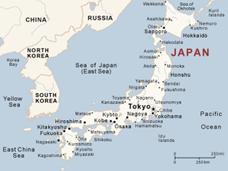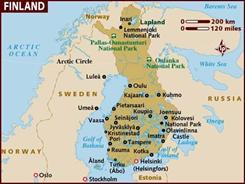National Churches: Japan and Finland
WEEK 5: JAPAN AND FINLAND

JAPAN
Geography:
Japan consists of a group of islands in the Pacific Ocean off the coast of Russia, China, and Korea. Its capital is Tokyo. Mountains and hills cover most of the land, leaving the majority of the population in the narrow coastal plains. The elevation of the land varies from sea level all the way to the top of Mt. Fuji at 12,388 feet. The mountains and thick forests contribute to the natural beauty of Japan. Most of the many steep, wild rivers that cross the surface cannot be navigated, but provide water for irrigation and hydroelectric power. And, many of the peaks are volcanoes; earthquakes and tsunami from quakes underwater or volcanic activity have caused much destruction every few years.
The four major islands are Hokkaido, Honshu, Kyushu, and Shikoku. Honshu is the largest, with most of the country’s population and the wonderful farming of the Kanto Plain. The climate of Japan varies with the warmth of the Japan current coming from the South Pacific and the cold of the Oyashio Current coming from the Arctic. Rain is abundant, but typhoons are common and destructive. As a land of coast after coast, it is not surprising that Japan has the world’s largest fishing industry. With the abundant rain comes the most important crop, rice. With a lack of flat land, the mountainsides are terraced; mulberry bushes that feed silk worms grow on the hillsides.
History:
In the 200s AD, Japan was ruled by warring clans, each headed by a chief. By the late 400s, Chinese influence began, with its system of writing and calculating the calendar. Buddhism came to Japan from China abut 550 AD. The Taika Reform of the 600s was an attempt by the Japanese imperial family to adopt the Chinese system of ruling. But, as the imperial family lost power, lords with their warriors called samurai really ruled the land, with the leading family at the time named shogun, or general, and really ruling Japan, but always in the name of the Emperor.
Japan for centuries was left alone by potential conquerors because of its island location. Kublai Khan (Remember Genghis Khan and Alexander Nevsky?) tried twice to conquer Japan; each time his fleet was turned back, destroyed by a typhoon – called by the Japanese kamikaze, or divine wind. Marco Polo first told Europeans of this rich land; Christopher Columbus had Japan in mind when he set sail. In 1543, Portuguese sailors reached Japan. And, in 1549, a Spanish priest named Francis Xavier converted many Japanese to Roman Catholicism. But the Tokugawa shoguns were afraid of the influence of Christian missionaries and threw them out of Japan, killing any Japanese Christians who refused to give up their faith. The Tokugawas also cut political ties with the outside world in the 1630s. Thus things remained until about 1800. Into this world came St. Nicholas, Evangelizer of Japan.
Finally, in 1853, the US, under Commodore Perry, sailed to Japan and concluded a treaty. Soon, other European nations had treaties, too. The shogunate came to an end and the Emperor reasserted his rights as ruler. But, as Japan grew more industrial, she became more imperialistic. In the late 1800s she attacked Russia and won Korea. By 1937, she attacked China and signed agreements with Nazi Germany. Most of eastern China was in Japanese hands by 1938. In 1941, Japan attacked Pearl Harbor. The US entered World War II and by 1946, after the atomic bombing of Hiroshima and Nagasaki, Japan was defeated. Japan lost its territory on the mainland of Asia, including Korea, and many of its smaller Pacific islands.
St. Nicholas, Evangelizer of Japan:
John Kasatkin was born almost 200 years ago in the land of Russia. John’s mother died when he was only five years old. John and his father were very poor, but John was smart and studied hard in school. In school, John heard about many lands far away – China and Japan. He wanted to tell the people of these lands about Jesus.
Then one day a note was put up on the bulletin at John’s school. The Russians in Japan were asking for a priest. John had finished his studies to be a priest. He first became a monk, and was given the name, Nicholas. Then he was ordained a priest. He was ready to go to Japan.
But, the samurai who ruled Japan hated all foreigners! They had their Shinto religion and did not want anyone talking about Jesus. One samurai appeared before Nicholas, angry at very thought that foreigners would come to change their beliefs. But Nicholas showed such love, the man could not hate him. Nicholas spent several years waiting, but while he waited he learned the language and customs of the Japanese people. Officially, Nicholas taught Russian to Japan’s future ministers and teachers. But, a few came to him in secret and learned a bout the Christian faith. Finally, Takuma Sawabe, the angry samurai, became Fr. Nicholas’s first convert. Many of these early believers including Sawabe were thrown in prison, just as the Romans had the earlier Christians. Not one of these Japanese Christians denied his faith.
bout the Christian faith. Finally, Takuma Sawabe, the angry samurai, became Fr. Nicholas’s first convert. Many of these early believers including Sawabe were thrown in prison, just as the Romans had the earlier Christians. Not one of these Japanese Christians denied his faith.
Finally, the rulers allowed the Christian faith. Nicholas could print Bibles in the Japanese language and open churches and teach priests. Foreigners were still not allowed in most parts of Japan, but these new Japanese priests could tell the people all over the country about Jesus. Soon there were hundreds of Christians all over Japan. Nicholas opened schools, both for boys and girls. This was new for the Japanese; girls usually did not go to school.
Nicholas became the first bishop of Japan. He built the beautiful Holy Resurrection Cathedral in Tokyo. He traveled all over Japan visiting Churches. He loved the Japanese people, so much so, that he stayed in Japan during the Russian-Japanese war, even though many of the Japanese rulers thought he was a spy! Nicholas died at the age of 76 in his beloved Japan and is called “Equal to the Apostles”.
Cultural traditions:
Japanese food is centered around beautiful presentation and ceremony. The Japanese have perfected the art of tea service. Fish is the chief source of protein; thin slices of raw fish are called sashimi and rice topped with raw fish and sliced vegetables and wrapped in seaweed is called sushi. Bring some sushi to class to share. Meals are eaten at low tables with elaborate lacquerware or porcelain dishes. Rice is served at almost every meal, along with the ubiquitous soy sauce and various types of seaweed.
Traditional Japanese dress is the kimono, a silk garment tied around the waist with a highly decorated sash called an obi. Wooden clogs and sandals complete the traditional outfit; all shoes are removed at the door.
 Japanese poetry is called haiku; can you write a haiku poem now? Calligraphy is also a favorite pastime. Sumo wrestling is a favorite sport.
Japanese poetry is called haiku; can you write a haiku poem now? Calligraphy is also a favorite pastime. Sumo wrestling is a favorite sport.
FINLAND
Geography:
Finland is located in Scandinavia, next to Russia and Sweden. Its capital is Helsinki. The terrain is notable for its variety – coastal lowlands with moderate climate due to the Gulf Stream, lake district in the center, and the upland tundra with its snow and midnight sun. Forests cover 2/3 of the land; plywood and paper are major products. Dairy farming in the lowlands and hydroelectric power are also major factors in the economy.
History:
The earliest people of Finland were the Lapps. They lived as nomadic hunters and still inhabit the northern tundra to this day. The ancestors of the modern Finns arrived from the areas of the Volga River and Ural Mountains in Russia. They formed loosely organized tribes living by hunting and fishing.
Sweden conquered Finland in the 1100s and 1200s. Many Swedes settled there, Swedish was made the official language, and Roman Catholicism the official religion. To this day, Finnish and Swedish are official languages and Finns and Swedes make up the majority of the population. In 1540 the Swedish king proclaimed Lutheranism to be the state religion.
In the 1500s to 1700s, Sweden and Russia fought many wars over possession of poor Finland, caught between them geographically. By 1809, Russia had conquered the country and organized it as a Grand Duchy with the Czar as overall Grand Duke. The duchy had self-rule. From this time came the Orthodox population of Finland. But, in 1899, Czar Nicholas II took away the self-rule and tried to force the Finnish people to accept the Russian language and culture. Finland stayed out of World War I and finally declared its independence at the time of the Russian Revolution in 1917. There were both Communist (Red) and non-Communist (White) political factions in Finland after the Russians were expelled, and it took a bloody civil war won by the Whites in 1918 to ensure a free Finland.
Finland never officially entered World War II, but both Russia and Germany marched thru Finland and at times occupied parts of it. Towns and forests alike were burned by the retreating troops. At the end of the war, the Allies granted to the Russians the territory they had invaded.
The Orthodox Church is the second largest Christian church in Finland, even though it comprises a small percentage of the population (about 60,00 Orthodox Finnish) There are Orthodox summer camps and even special religion classes in the public schools.
Cultural traditions:
Finland has a rich folk culture. In 1835, a country doctor named Elias Lonnrot published a collection of Finnish peasant poems and chants called the “Kalevala.” This work inspired the music of Jean Sibelius (Listen to some of his music in class?) and the poetry of Longfellow was patterned after the Kalevala.
Finnish food is strongly influenced by the sea and the dairy industry. Look for strong-flavored cheeses and a multitude of seafood options. Especially interesting, and shared with Sweden and Denmark, is the Smorgasbord, with a variety of breads, cheeses, seafood, toppings to be chosen and sampled. Make your own class Smorgasbord?
Quiz Questions:
- These are nations with a Orthodox minority, but a strong Orthodox presence. Compare and contrast with each other and with our own country.
- Compare the ministry of St. Nicholas with that of St. Innocent, St. Frumentius, St. Gregory of Armenia, and Sts. Cyril and Methodius. What made these men so special?